Dynamic Strategy: Facebook Stakeholder Analysis Report, MBA501
VerifiedAdded on 2022/10/11
|14
|2631
|13
Report
AI Summary
This report provides a comprehensive stakeholder analysis of Facebook, examining its challenges, evolution, and key stakeholder groups. It begins with an introduction to Facebook, outlining its vision, mission, recent developments, and industry trends. A stakeholder view model is presented to visually represent Facebook's key stakeholders, followed by a detailed table identifying specific stakeholders within each group. The analysis then categorizes stakeholders based on the Freeman stakeholder theory, focusing on four selected stakeholder groups: customers, employees, government, and shareholders. The report delves into the behavior, motives, and potential coalitions of each stakeholder group, offering valuable insights into their roles and influence on Facebook. The report also includes an executive summary, table of contents, and bibliography.
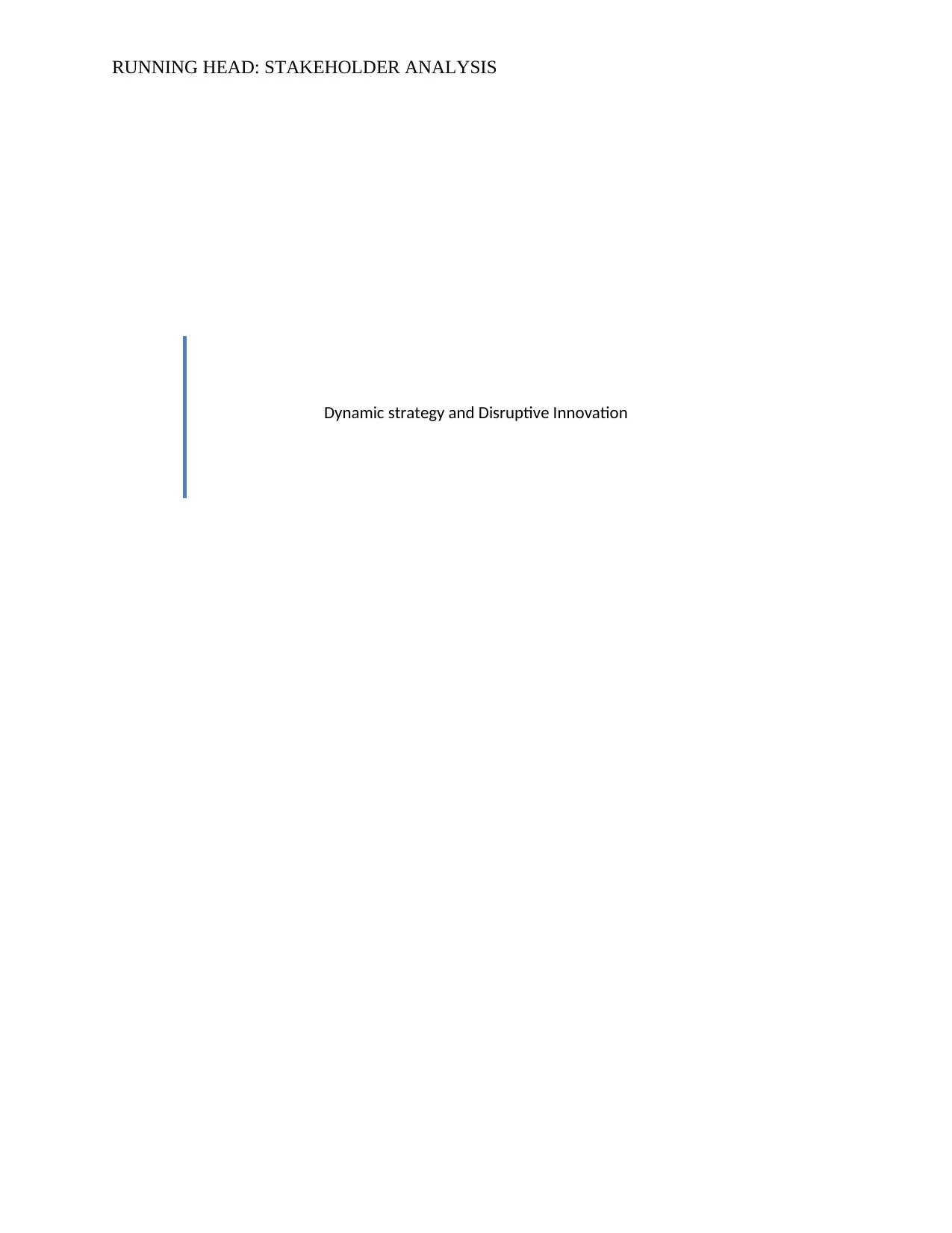
RUNNING HEAD: STAKEHOLDER ANALYSIS
Dynamic strategy and Disruptive Innovation
Dynamic strategy and Disruptive Innovation
Paraphrase This Document
Need a fresh take? Get an instant paraphrase of this document with our AI Paraphraser
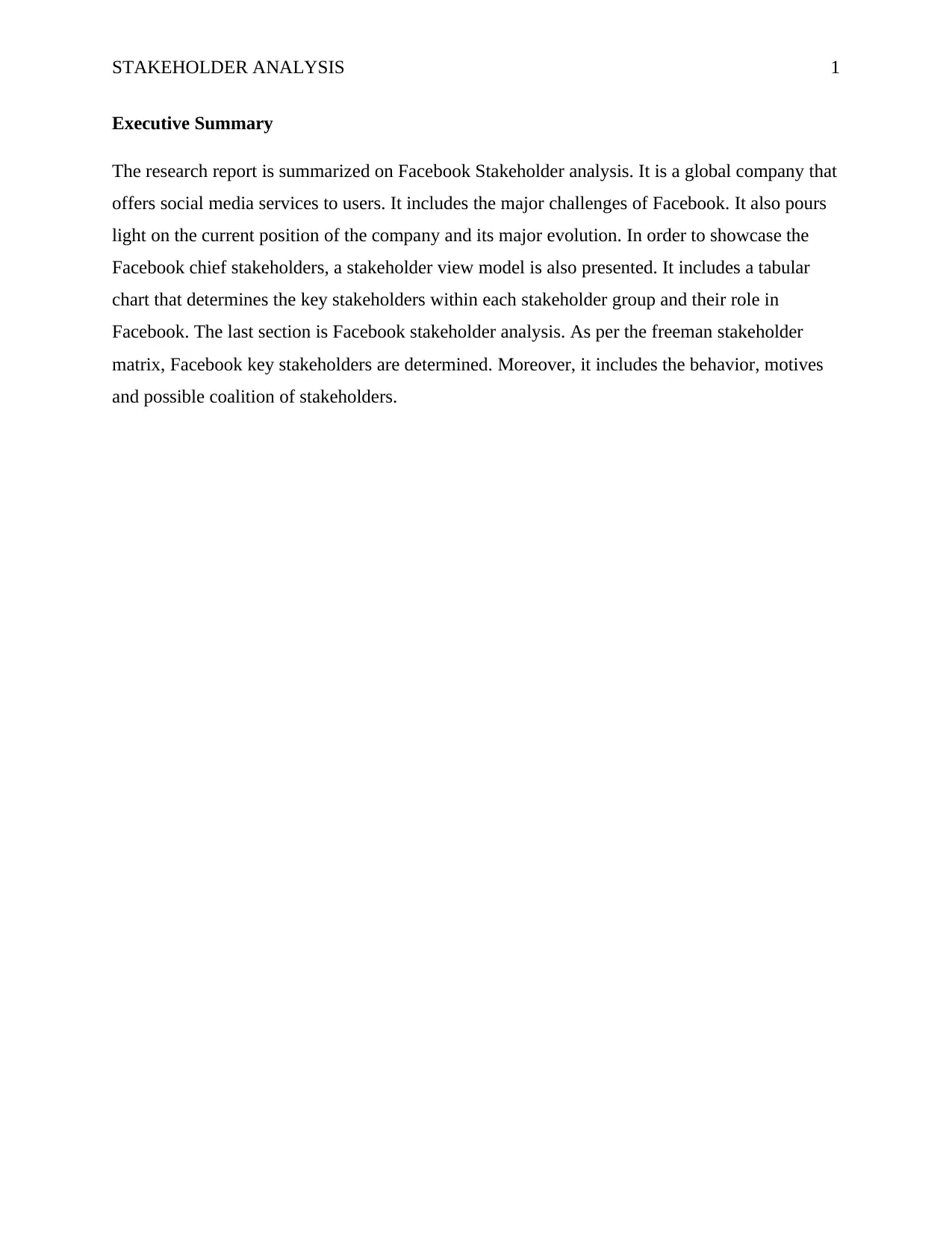
STAKEHOLDER ANALYSIS 1
Executive Summary
The research report is summarized on Facebook Stakeholder analysis. It is a global company that
offers social media services to users. It includes the major challenges of Facebook. It also pours
light on the current position of the company and its major evolution. In order to showcase the
Facebook chief stakeholders, a stakeholder view model is also presented. It includes a tabular
chart that determines the key stakeholders within each stakeholder group and their role in
Facebook. The last section is Facebook stakeholder analysis. As per the freeman stakeholder
matrix, Facebook key stakeholders are determined. Moreover, it includes the behavior, motives
and possible coalition of stakeholders.
Executive Summary
The research report is summarized on Facebook Stakeholder analysis. It is a global company that
offers social media services to users. It includes the major challenges of Facebook. It also pours
light on the current position of the company and its major evolution. In order to showcase the
Facebook chief stakeholders, a stakeholder view model is also presented. It includes a tabular
chart that determines the key stakeholders within each stakeholder group and their role in
Facebook. The last section is Facebook stakeholder analysis. As per the freeman stakeholder
matrix, Facebook key stakeholders are determined. Moreover, it includes the behavior, motives
and possible coalition of stakeholders.
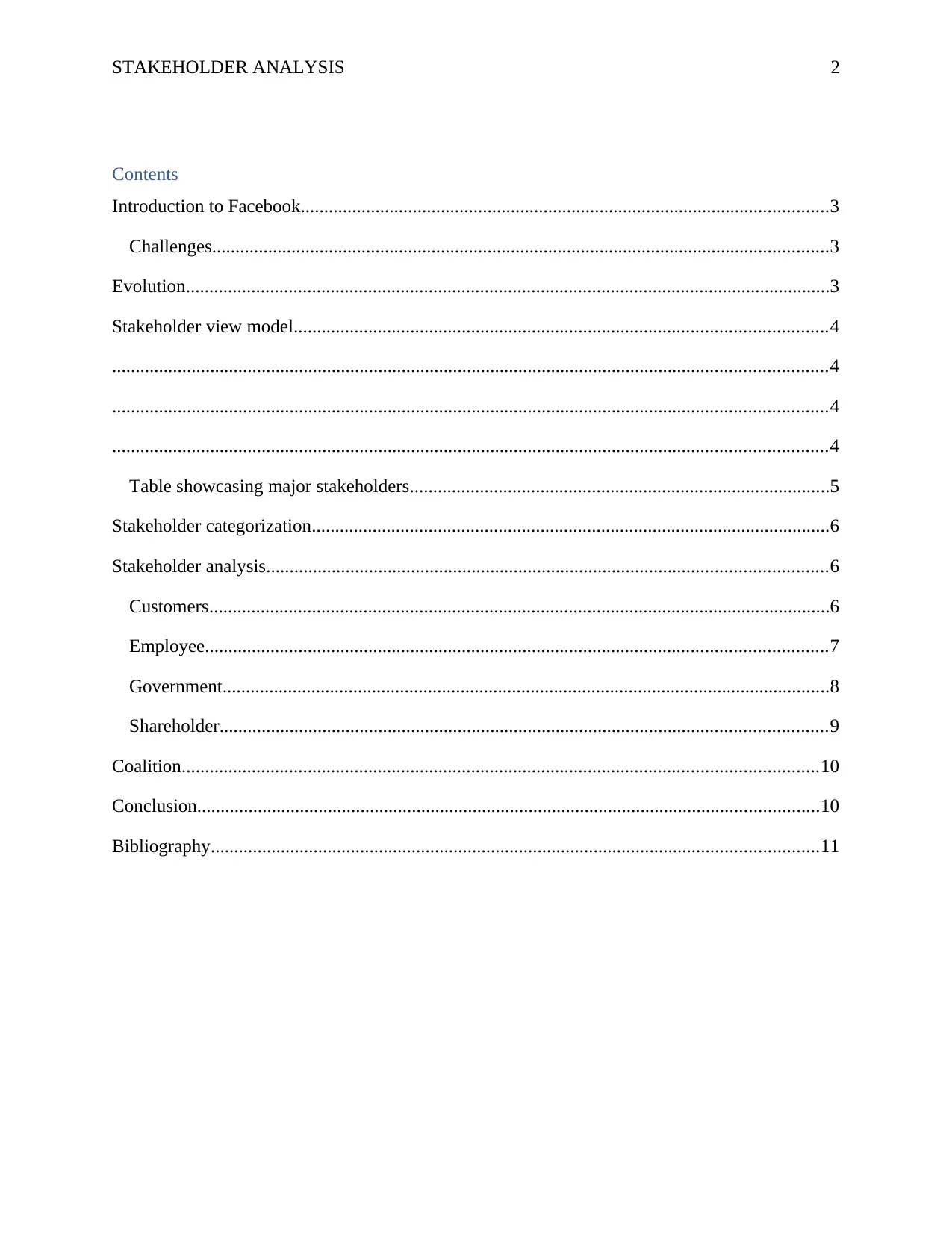
STAKEHOLDER ANALYSIS 2
Contents
Introduction to Facebook.................................................................................................................3
Challenges....................................................................................................................................3
Evolution..........................................................................................................................................3
Stakeholder view model..................................................................................................................4
.........................................................................................................................................................4
.........................................................................................................................................................4
.........................................................................................................................................................4
Table showcasing major stakeholders..........................................................................................5
Stakeholder categorization...............................................................................................................6
Stakeholder analysis........................................................................................................................6
Customers.....................................................................................................................................6
Employee.....................................................................................................................................7
Government..................................................................................................................................8
Shareholder..................................................................................................................................9
Coalition........................................................................................................................................10
Conclusion.....................................................................................................................................10
Bibliography..................................................................................................................................11
Contents
Introduction to Facebook.................................................................................................................3
Challenges....................................................................................................................................3
Evolution..........................................................................................................................................3
Stakeholder view model..................................................................................................................4
.........................................................................................................................................................4
.........................................................................................................................................................4
.........................................................................................................................................................4
Table showcasing major stakeholders..........................................................................................5
Stakeholder categorization...............................................................................................................6
Stakeholder analysis........................................................................................................................6
Customers.....................................................................................................................................6
Employee.....................................................................................................................................7
Government..................................................................................................................................8
Shareholder..................................................................................................................................9
Coalition........................................................................................................................................10
Conclusion.....................................................................................................................................10
Bibliography..................................................................................................................................11
⊘ This is a preview!⊘
Do you want full access?
Subscribe today to unlock all pages.

Trusted by 1+ million students worldwide
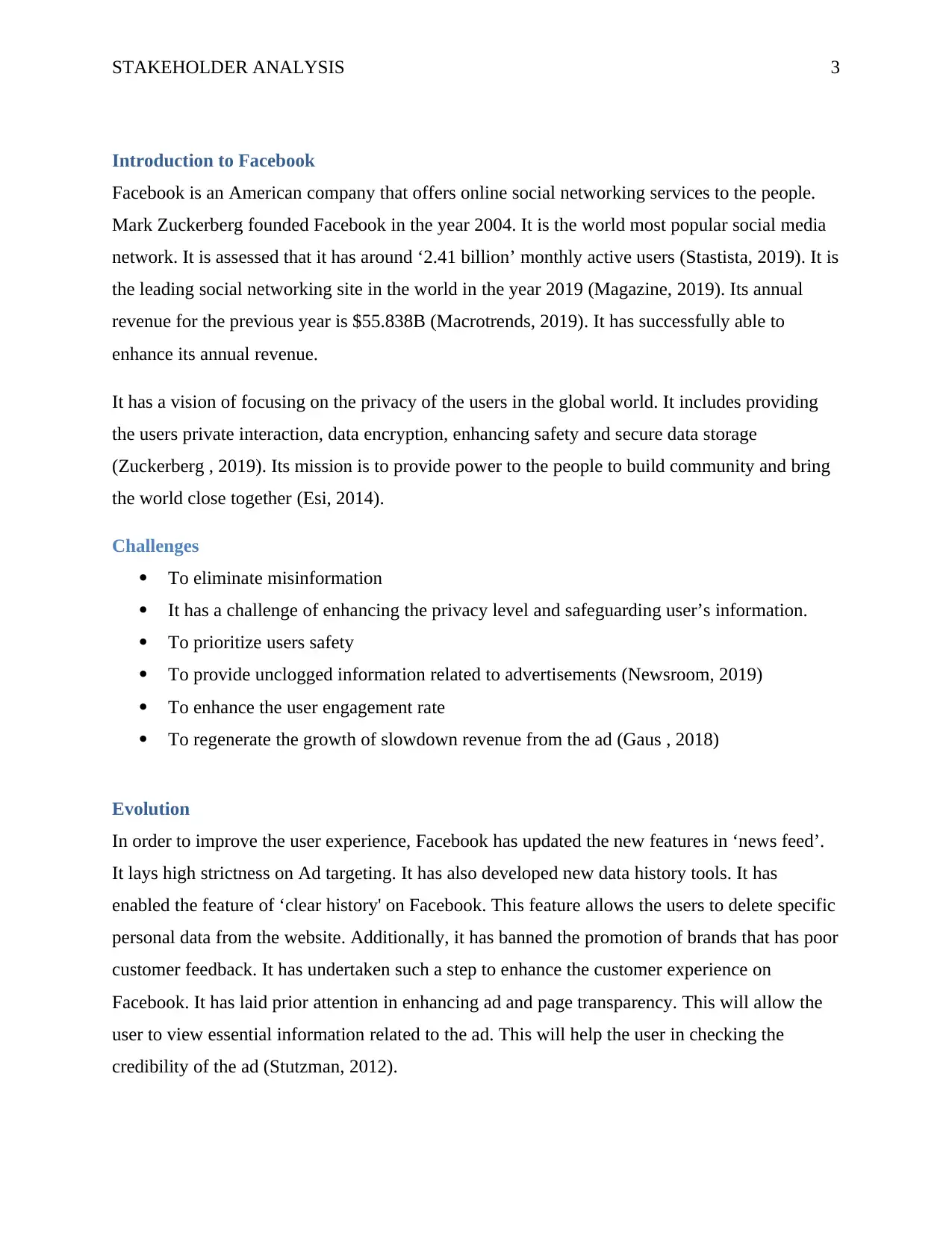
STAKEHOLDER ANALYSIS 3
Introduction to Facebook
Facebook is an American company that offers online social networking services to the people.
Mark Zuckerberg founded Facebook in the year 2004. It is the world most popular social media
network. It is assessed that it has around ‘2.41 billion’ monthly active users (Stastista, 2019). It is
the leading social networking site in the world in the year 2019 (Magazine, 2019). Its annual
revenue for the previous year is $55.838B (Macrotrends, 2019). It has successfully able to
enhance its annual revenue.
It has a vision of focusing on the privacy of the users in the global world. It includes providing
the users private interaction, data encryption, enhancing safety and secure data storage
(Zuckerberg , 2019). Its mission is to provide power to the people to build community and bring
the world close together (Esi, 2014).
Challenges
To eliminate misinformation
It has a challenge of enhancing the privacy level and safeguarding user’s information.
To prioritize users safety
To provide unclogged information related to advertisements (Newsroom, 2019)
To enhance the user engagement rate
To regenerate the growth of slowdown revenue from the ad (Gaus , 2018)
Evolution
In order to improve the user experience, Facebook has updated the new features in ‘news feed’.
It lays high strictness on Ad targeting. It has also developed new data history tools. It has
enabled the feature of ‘clear history' on Facebook. This feature allows the users to delete specific
personal data from the website. Additionally, it has banned the promotion of brands that has poor
customer feedback. It has undertaken such a step to enhance the customer experience on
Facebook. It has laid prior attention in enhancing ad and page transparency. This will allow the
user to view essential information related to the ad. This will help the user in checking the
credibility of the ad (Stutzman, 2012).
Introduction to Facebook
Facebook is an American company that offers online social networking services to the people.
Mark Zuckerberg founded Facebook in the year 2004. It is the world most popular social media
network. It is assessed that it has around ‘2.41 billion’ monthly active users (Stastista, 2019). It is
the leading social networking site in the world in the year 2019 (Magazine, 2019). Its annual
revenue for the previous year is $55.838B (Macrotrends, 2019). It has successfully able to
enhance its annual revenue.
It has a vision of focusing on the privacy of the users in the global world. It includes providing
the users private interaction, data encryption, enhancing safety and secure data storage
(Zuckerberg , 2019). Its mission is to provide power to the people to build community and bring
the world close together (Esi, 2014).
Challenges
To eliminate misinformation
It has a challenge of enhancing the privacy level and safeguarding user’s information.
To prioritize users safety
To provide unclogged information related to advertisements (Newsroom, 2019)
To enhance the user engagement rate
To regenerate the growth of slowdown revenue from the ad (Gaus , 2018)
Evolution
In order to improve the user experience, Facebook has updated the new features in ‘news feed’.
It lays high strictness on Ad targeting. It has also developed new data history tools. It has
enabled the feature of ‘clear history' on Facebook. This feature allows the users to delete specific
personal data from the website. Additionally, it has banned the promotion of brands that has poor
customer feedback. It has undertaken such a step to enhance the customer experience on
Facebook. It has laid prior attention in enhancing ad and page transparency. This will allow the
user to view essential information related to the ad. This will help the user in checking the
credibility of the ad (Stutzman, 2012).
Paraphrase This Document
Need a fresh take? Get an instant paraphrase of this document with our AI Paraphraser
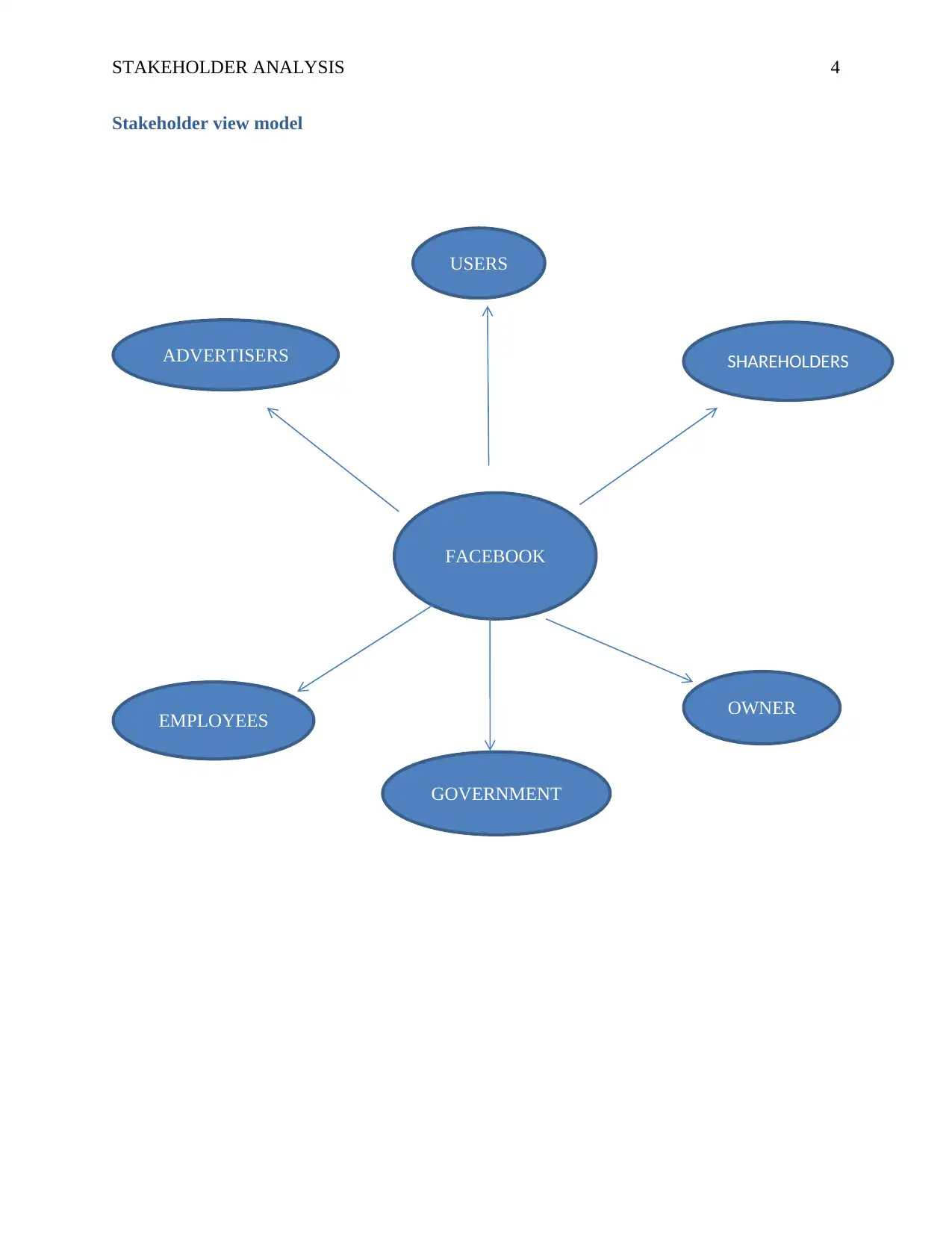
STAKEHOLDER ANALYSIS 4
Stakeholder view model
FACEBOOK
EMPLOYEES
ADVERTISERS
USERS
SHAREHOLDERS
OWNER
GOVERNMENT
Stakeholder view model
EMPLOYEES
ADVERTISERS
USERS
SHAREHOLDERS
OWNER
GOVERNMENT
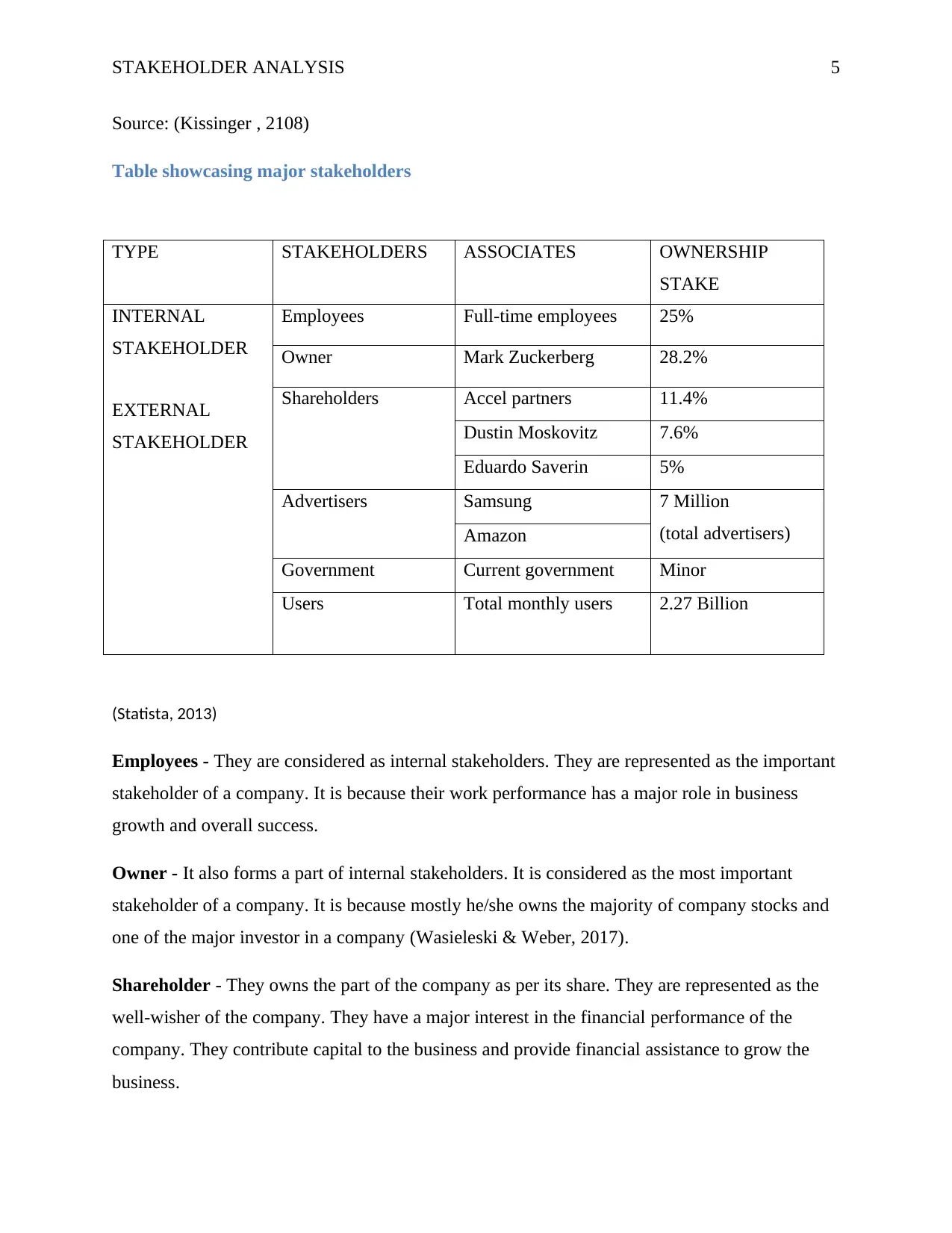
STAKEHOLDER ANALYSIS 5
Source: (Kissinger , 2108)
Table showcasing major stakeholders
TYPE STAKEHOLDERS ASSOCIATES OWNERSHIP
STAKE
INTERNAL
STAKEHOLDER
EXTERNAL
STAKEHOLDER
Employees Full-time employees 25%
Owner Mark Zuckerberg 28.2%
Shareholders Accel partners 11.4%
Dustin Moskovitz 7.6%
Eduardo Saverin 5%
Advertisers Samsung 7 Million
(total advertisers)Amazon
Government Current government Minor
Users Total monthly users 2.27 Billion
(Statista, 2013)
Employees - They are considered as internal stakeholders. They are represented as the important
stakeholder of a company. It is because their work performance has a major role in business
growth and overall success.
Owner - It also forms a part of internal stakeholders. It is considered as the most important
stakeholder of a company. It is because mostly he/she owns the majority of company stocks and
one of the major investor in a company (Wasieleski & Weber, 2017).
Shareholder - They owns the part of the company as per its share. They are represented as the
well-wisher of the company. They have a major interest in the financial performance of the
company. They contribute capital to the business and provide financial assistance to grow the
business.
Source: (Kissinger , 2108)
Table showcasing major stakeholders
TYPE STAKEHOLDERS ASSOCIATES OWNERSHIP
STAKE
INTERNAL
STAKEHOLDER
EXTERNAL
STAKEHOLDER
Employees Full-time employees 25%
Owner Mark Zuckerberg 28.2%
Shareholders Accel partners 11.4%
Dustin Moskovitz 7.6%
Eduardo Saverin 5%
Advertisers Samsung 7 Million
(total advertisers)Amazon
Government Current government Minor
Users Total monthly users 2.27 Billion
(Statista, 2013)
Employees - They are considered as internal stakeholders. They are represented as the important
stakeholder of a company. It is because their work performance has a major role in business
growth and overall success.
Owner - It also forms a part of internal stakeholders. It is considered as the most important
stakeholder of a company. It is because mostly he/she owns the majority of company stocks and
one of the major investor in a company (Wasieleski & Weber, 2017).
Shareholder - They owns the part of the company as per its share. They are represented as the
well-wisher of the company. They have a major interest in the financial performance of the
company. They contribute capital to the business and provide financial assistance to grow the
business.
⊘ This is a preview!⊘
Do you want full access?
Subscribe today to unlock all pages.

Trusted by 1+ million students worldwide
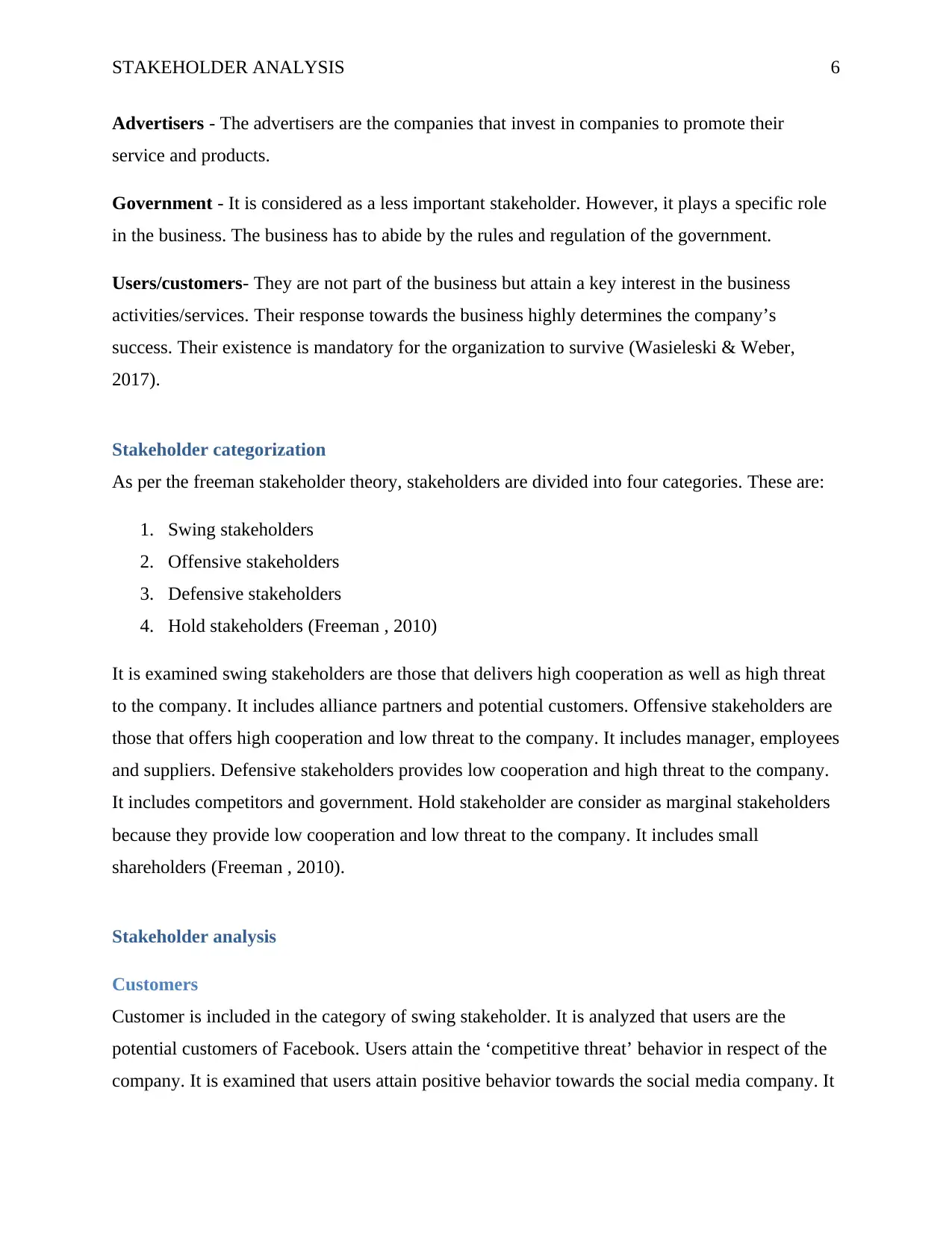
STAKEHOLDER ANALYSIS 6
Advertisers - The advertisers are the companies that invest in companies to promote their
service and products.
Government - It is considered as a less important stakeholder. However, it plays a specific role
in the business. The business has to abide by the rules and regulation of the government.
Users/customers- They are not part of the business but attain a key interest in the business
activities/services. Their response towards the business highly determines the company’s
success. Their existence is mandatory for the organization to survive (Wasieleski & Weber,
2017).
Stakeholder categorization
As per the freeman stakeholder theory, stakeholders are divided into four categories. These are:
1. Swing stakeholders
2. Offensive stakeholders
3. Defensive stakeholders
4. Hold stakeholders (Freeman , 2010)
It is examined swing stakeholders are those that delivers high cooperation as well as high threat
to the company. It includes alliance partners and potential customers. Offensive stakeholders are
those that offers high cooperation and low threat to the company. It includes manager, employees
and suppliers. Defensive stakeholders provides low cooperation and high threat to the company.
It includes competitors and government. Hold stakeholder are consider as marginal stakeholders
because they provide low cooperation and low threat to the company. It includes small
shareholders (Freeman , 2010).
Stakeholder analysis
Customers
Customer is included in the category of swing stakeholder. It is analyzed that users are the
potential customers of Facebook. Users attain the ‘competitive threat’ behavior in respect of the
company. It is examined that users attain positive behavior towards the social media company. It
Advertisers - The advertisers are the companies that invest in companies to promote their
service and products.
Government - It is considered as a less important stakeholder. However, it plays a specific role
in the business. The business has to abide by the rules and regulation of the government.
Users/customers- They are not part of the business but attain a key interest in the business
activities/services. Their response towards the business highly determines the company’s
success. Their existence is mandatory for the organization to survive (Wasieleski & Weber,
2017).
Stakeholder categorization
As per the freeman stakeholder theory, stakeholders are divided into four categories. These are:
1. Swing stakeholders
2. Offensive stakeholders
3. Defensive stakeholders
4. Hold stakeholders (Freeman , 2010)
It is examined swing stakeholders are those that delivers high cooperation as well as high threat
to the company. It includes alliance partners and potential customers. Offensive stakeholders are
those that offers high cooperation and low threat to the company. It includes manager, employees
and suppliers. Defensive stakeholders provides low cooperation and high threat to the company.
It includes competitors and government. Hold stakeholder are consider as marginal stakeholders
because they provide low cooperation and low threat to the company. It includes small
shareholders (Freeman , 2010).
Stakeholder analysis
Customers
Customer is included in the category of swing stakeholder. It is analyzed that users are the
potential customers of Facebook. Users attain the ‘competitive threat’ behavior in respect of the
company. It is examined that users attain positive behavior towards the social media company. It
Paraphrase This Document
Need a fresh take? Get an instant paraphrase of this document with our AI Paraphraser
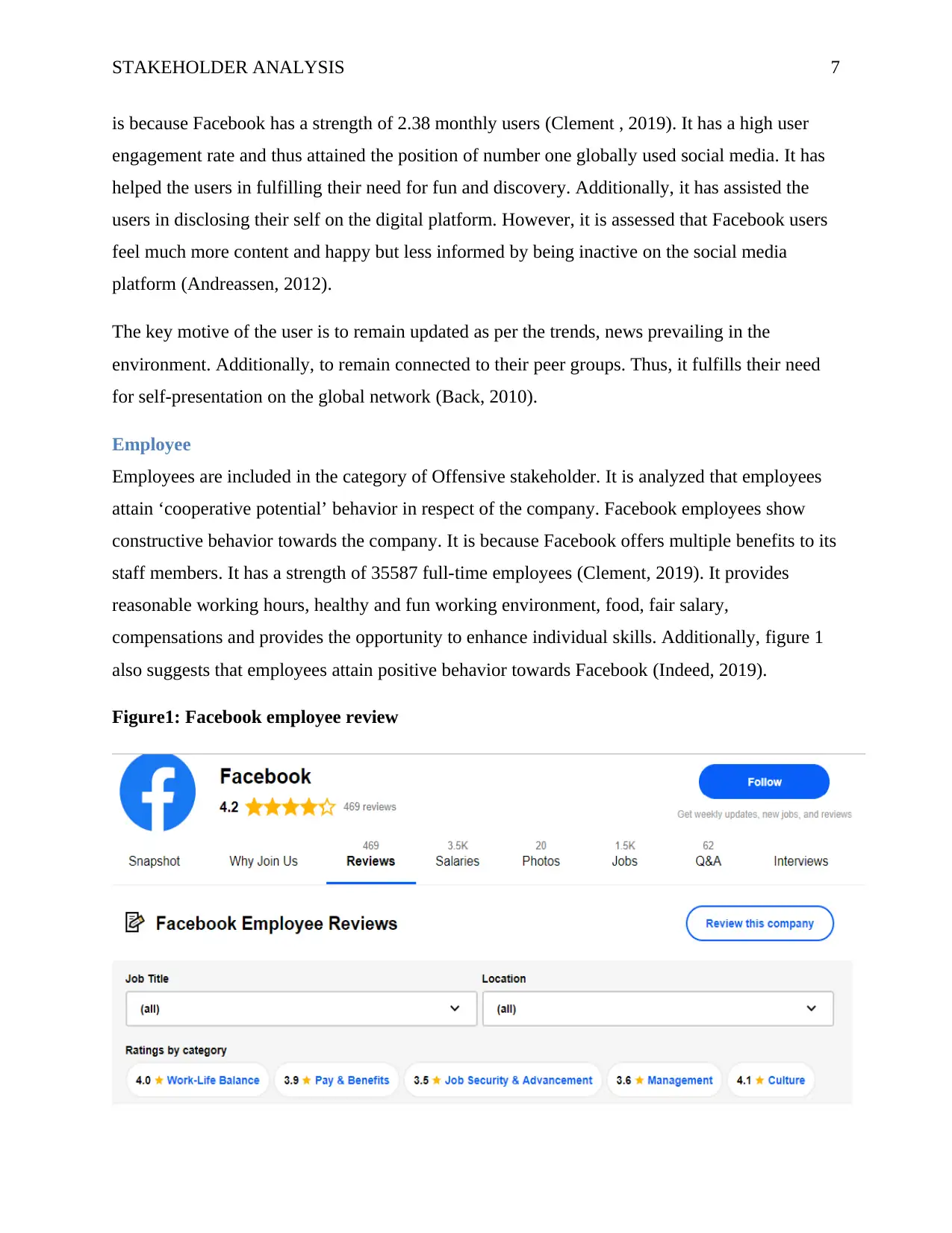
STAKEHOLDER ANALYSIS 7
is because Facebook has a strength of 2.38 monthly users (Clement , 2019). It has a high user
engagement rate and thus attained the position of number one globally used social media. It has
helped the users in fulfilling their need for fun and discovery. Additionally, it has assisted the
users in disclosing their self on the digital platform. However, it is assessed that Facebook users
feel much more content and happy but less informed by being inactive on the social media
platform (Andreassen, 2012).
The key motive of the user is to remain updated as per the trends, news prevailing in the
environment. Additionally, to remain connected to their peer groups. Thus, it fulfills their need
for self-presentation on the global network (Back, 2010).
Employee
Employees are included in the category of Offensive stakeholder. It is analyzed that employees
attain ‘cooperative potential’ behavior in respect of the company. Facebook employees show
constructive behavior towards the company. It is because Facebook offers multiple benefits to its
staff members. It has a strength of 35587 full-time employees (Clement, 2019). It provides
reasonable working hours, healthy and fun working environment, food, fair salary,
compensations and provides the opportunity to enhance individual skills. Additionally, figure 1
also suggests that employees attain positive behavior towards Facebook (Indeed, 2019).
Figure1: Facebook employee review
is because Facebook has a strength of 2.38 monthly users (Clement , 2019). It has a high user
engagement rate and thus attained the position of number one globally used social media. It has
helped the users in fulfilling their need for fun and discovery. Additionally, it has assisted the
users in disclosing their self on the digital platform. However, it is assessed that Facebook users
feel much more content and happy but less informed by being inactive on the social media
platform (Andreassen, 2012).
The key motive of the user is to remain updated as per the trends, news prevailing in the
environment. Additionally, to remain connected to their peer groups. Thus, it fulfills their need
for self-presentation on the global network (Back, 2010).
Employee
Employees are included in the category of Offensive stakeholder. It is analyzed that employees
attain ‘cooperative potential’ behavior in respect of the company. Facebook employees show
constructive behavior towards the company. It is because Facebook offers multiple benefits to its
staff members. It has a strength of 35587 full-time employees (Clement, 2019). It provides
reasonable working hours, healthy and fun working environment, food, fair salary,
compensations and provides the opportunity to enhance individual skills. Additionally, figure 1
also suggests that employees attain positive behavior towards Facebook (Indeed, 2019).
Figure1: Facebook employee review
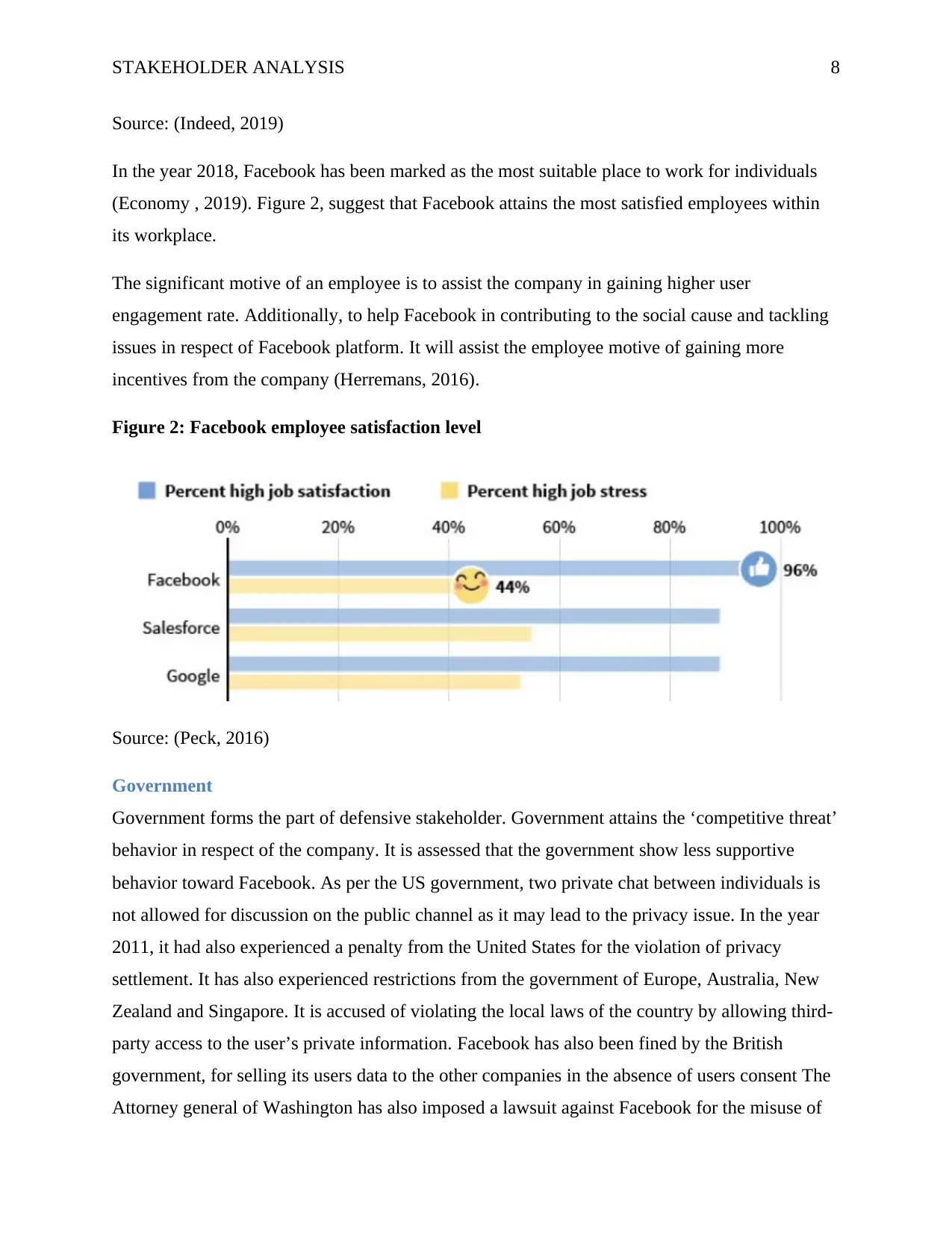
STAKEHOLDER ANALYSIS 8
Source: (Indeed, 2019)
In the year 2018, Facebook has been marked as the most suitable place to work for individuals
(Economy , 2019). Figure 2, suggest that Facebook attains the most satisfied employees within
its workplace.
The significant motive of an employee is to assist the company in gaining higher user
engagement rate. Additionally, to help Facebook in contributing to the social cause and tackling
issues in respect of Facebook platform. It will assist the employee motive of gaining more
incentives from the company (Herremans, 2016).
Figure 2: Facebook employee satisfaction level
Source: (Peck, 2016)
Government
Government forms the part of defensive stakeholder. Government attains the ‘competitive threat’
behavior in respect of the company. It is assessed that the government show less supportive
behavior toward Facebook. As per the US government, two private chat between individuals is
not allowed for discussion on the public channel as it may lead to the privacy issue. In the year
2011, it had also experienced a penalty from the United States for the violation of privacy
settlement. It has also experienced restrictions from the government of Europe, Australia, New
Zealand and Singapore. It is accused of violating the local laws of the country by allowing third-
party access to the user’s private information. Facebook has also been fined by the British
government, for selling its users data to the other companies in the absence of users consent The
Attorney general of Washington has also imposed a lawsuit against Facebook for the misuse of
Source: (Indeed, 2019)
In the year 2018, Facebook has been marked as the most suitable place to work for individuals
(Economy , 2019). Figure 2, suggest that Facebook attains the most satisfied employees within
its workplace.
The significant motive of an employee is to assist the company in gaining higher user
engagement rate. Additionally, to help Facebook in contributing to the social cause and tackling
issues in respect of Facebook platform. It will assist the employee motive of gaining more
incentives from the company (Herremans, 2016).
Figure 2: Facebook employee satisfaction level
Source: (Peck, 2016)
Government
Government forms the part of defensive stakeholder. Government attains the ‘competitive threat’
behavior in respect of the company. It is assessed that the government show less supportive
behavior toward Facebook. As per the US government, two private chat between individuals is
not allowed for discussion on the public channel as it may lead to the privacy issue. In the year
2011, it had also experienced a penalty from the United States for the violation of privacy
settlement. It has also experienced restrictions from the government of Europe, Australia, New
Zealand and Singapore. It is accused of violating the local laws of the country by allowing third-
party access to the user’s private information. Facebook has also been fined by the British
government, for selling its users data to the other companies in the absence of users consent The
Attorney general of Washington has also imposed a lawsuit against Facebook for the misuse of
⊘ This is a preview!⊘
Do you want full access?
Subscribe today to unlock all pages.

Trusted by 1+ million students worldwide
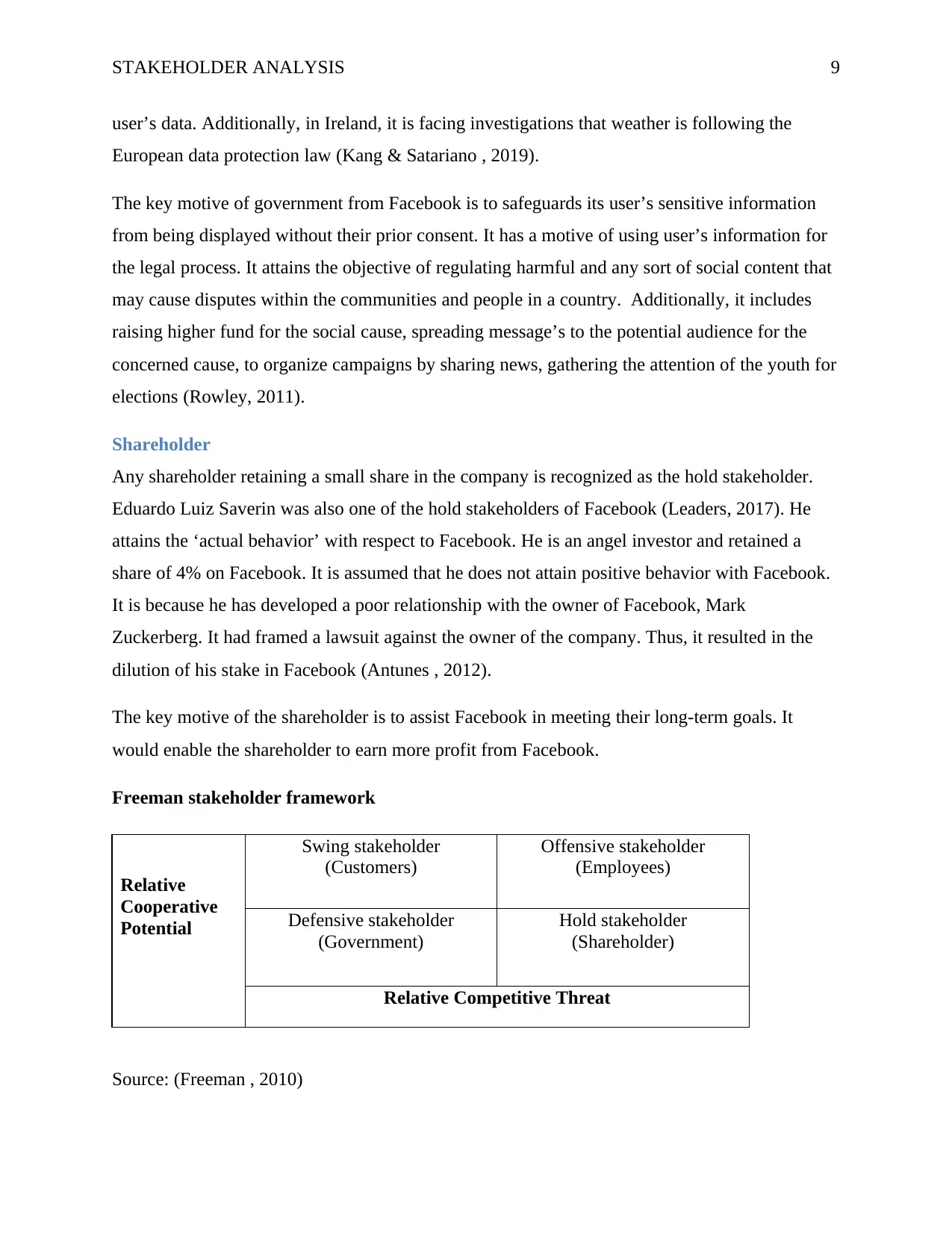
STAKEHOLDER ANALYSIS 9
user’s data. Additionally, in Ireland, it is facing investigations that weather is following the
European data protection law (Kang & Satariano , 2019).
The key motive of government from Facebook is to safeguards its user’s sensitive information
from being displayed without their prior consent. It has a motive of using user’s information for
the legal process. It attains the objective of regulating harmful and any sort of social content that
may cause disputes within the communities and people in a country. Additionally, it includes
raising higher fund for the social cause, spreading message’s to the potential audience for the
concerned cause, to organize campaigns by sharing news, gathering the attention of the youth for
elections (Rowley, 2011).
Shareholder
Any shareholder retaining a small share in the company is recognized as the hold stakeholder.
Eduardo Luiz Saverin was also one of the hold stakeholders of Facebook (Leaders, 2017). He
attains the ‘actual behavior’ with respect to Facebook. He is an angel investor and retained a
share of 4% on Facebook. It is assumed that he does not attain positive behavior with Facebook.
It is because he has developed a poor relationship with the owner of Facebook, Mark
Zuckerberg. It had framed a lawsuit against the owner of the company. Thus, it resulted in the
dilution of his stake in Facebook (Antunes , 2012).
The key motive of the shareholder is to assist Facebook in meeting their long-term goals. It
would enable the shareholder to earn more profit from Facebook.
Freeman stakeholder framework
Relative
Cooperative
Potential
Swing stakeholder
(Customers)
Offensive stakeholder
(Employees)
Defensive stakeholder
(Government)
Hold stakeholder
(Shareholder)
Relative Competitive Threat
Source: (Freeman , 2010)
user’s data. Additionally, in Ireland, it is facing investigations that weather is following the
European data protection law (Kang & Satariano , 2019).
The key motive of government from Facebook is to safeguards its user’s sensitive information
from being displayed without their prior consent. It has a motive of using user’s information for
the legal process. It attains the objective of regulating harmful and any sort of social content that
may cause disputes within the communities and people in a country. Additionally, it includes
raising higher fund for the social cause, spreading message’s to the potential audience for the
concerned cause, to organize campaigns by sharing news, gathering the attention of the youth for
elections (Rowley, 2011).
Shareholder
Any shareholder retaining a small share in the company is recognized as the hold stakeholder.
Eduardo Luiz Saverin was also one of the hold stakeholders of Facebook (Leaders, 2017). He
attains the ‘actual behavior’ with respect to Facebook. He is an angel investor and retained a
share of 4% on Facebook. It is assumed that he does not attain positive behavior with Facebook.
It is because he has developed a poor relationship with the owner of Facebook, Mark
Zuckerberg. It had framed a lawsuit against the owner of the company. Thus, it resulted in the
dilution of his stake in Facebook (Antunes , 2012).
The key motive of the shareholder is to assist Facebook in meeting their long-term goals. It
would enable the shareholder to earn more profit from Facebook.
Freeman stakeholder framework
Relative
Cooperative
Potential
Swing stakeholder
(Customers)
Offensive stakeholder
(Employees)
Defensive stakeholder
(Government)
Hold stakeholder
(Shareholder)
Relative Competitive Threat
Source: (Freeman , 2010)
Paraphrase This Document
Need a fresh take? Get an instant paraphrase of this document with our AI Paraphraser
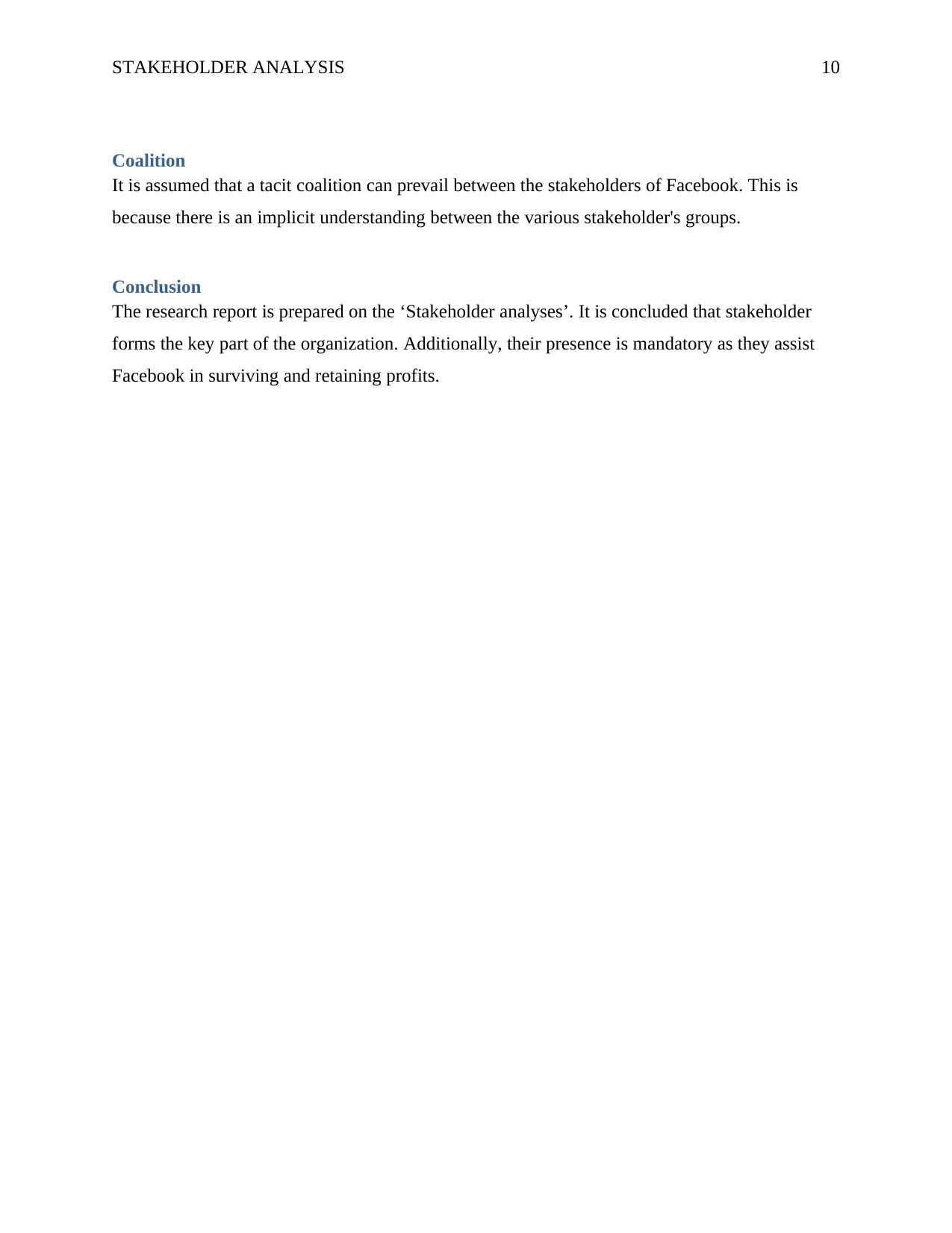
STAKEHOLDER ANALYSIS 10
Coalition
It is assumed that a tacit coalition can prevail between the stakeholders of Facebook. This is
because there is an implicit understanding between the various stakeholder's groups.
Conclusion
The research report is prepared on the ‘Stakeholder analyses’. It is concluded that stakeholder
forms the key part of the organization. Additionally, their presence is mandatory as they assist
Facebook in surviving and retaining profits.
Coalition
It is assumed that a tacit coalition can prevail between the stakeholders of Facebook. This is
because there is an implicit understanding between the various stakeholder's groups.
Conclusion
The research report is prepared on the ‘Stakeholder analyses’. It is concluded that stakeholder
forms the key part of the organization. Additionally, their presence is mandatory as they assist
Facebook in surviving and retaining profits.
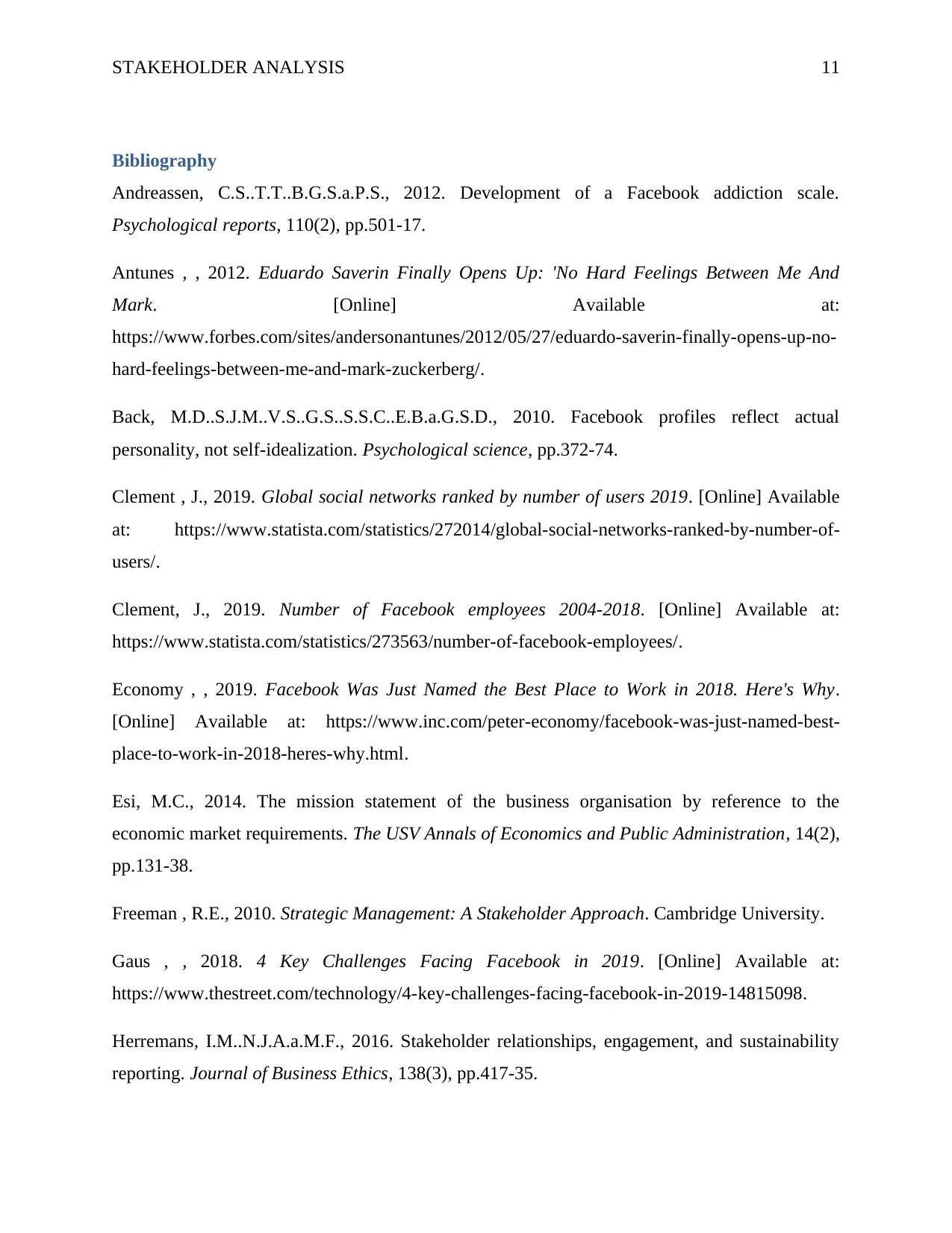
STAKEHOLDER ANALYSIS 11
Bibliography
Andreassen, C.S..T.T..B.G.S.a.P.S., 2012. Development of a Facebook addiction scale.
Psychological reports, 110(2), pp.501-17.
Antunes , , 2012. Eduardo Saverin Finally Opens Up: 'No Hard Feelings Between Me And
Mark. [Online] Available at:
https://www.forbes.com/sites/andersonantunes/2012/05/27/eduardo-saverin-finally-opens-up-no-
hard-feelings-between-me-and-mark-zuckerberg/.
Back, M.D..S.J.M..V.S..G.S..S.S.C..E.B.a.G.S.D., 2010. Facebook profiles reflect actual
personality, not self-idealization. Psychological science, pp.372-74.
Clement , J., 2019. Global social networks ranked by number of users 2019. [Online] Available
at: https://www.statista.com/statistics/272014/global-social-networks-ranked-by-number-of-
users/.
Clement, J., 2019. Number of Facebook employees 2004-2018. [Online] Available at:
https://www.statista.com/statistics/273563/number-of-facebook-employees/.
Economy , , 2019. Facebook Was Just Named the Best Place to Work in 2018. Here's Why.
[Online] Available at: https://www.inc.com/peter-economy/facebook-was-just-named-best-
place-to-work-in-2018-heres-why.html.
Esi, M.C., 2014. The mission statement of the business organisation by reference to the
economic market requirements. The USV Annals of Economics and Public Administration, 14(2),
pp.131-38.
Freeman , R.E., 2010. Strategic Management: A Stakeholder Approach. Cambridge University.
Gaus , , 2018. 4 Key Challenges Facing Facebook in 2019. [Online] Available at:
https://www.thestreet.com/technology/4-key-challenges-facing-facebook-in-2019-14815098.
Herremans, I.M..N.J.A.a.M.F., 2016. Stakeholder relationships, engagement, and sustainability
reporting. Journal of Business Ethics, 138(3), pp.417-35.
Bibliography
Andreassen, C.S..T.T..B.G.S.a.P.S., 2012. Development of a Facebook addiction scale.
Psychological reports, 110(2), pp.501-17.
Antunes , , 2012. Eduardo Saverin Finally Opens Up: 'No Hard Feelings Between Me And
Mark. [Online] Available at:
https://www.forbes.com/sites/andersonantunes/2012/05/27/eduardo-saverin-finally-opens-up-no-
hard-feelings-between-me-and-mark-zuckerberg/.
Back, M.D..S.J.M..V.S..G.S..S.S.C..E.B.a.G.S.D., 2010. Facebook profiles reflect actual
personality, not self-idealization. Psychological science, pp.372-74.
Clement , J., 2019. Global social networks ranked by number of users 2019. [Online] Available
at: https://www.statista.com/statistics/272014/global-social-networks-ranked-by-number-of-
users/.
Clement, J., 2019. Number of Facebook employees 2004-2018. [Online] Available at:
https://www.statista.com/statistics/273563/number-of-facebook-employees/.
Economy , , 2019. Facebook Was Just Named the Best Place to Work in 2018. Here's Why.
[Online] Available at: https://www.inc.com/peter-economy/facebook-was-just-named-best-
place-to-work-in-2018-heres-why.html.
Esi, M.C., 2014. The mission statement of the business organisation by reference to the
economic market requirements. The USV Annals of Economics and Public Administration, 14(2),
pp.131-38.
Freeman , R.E., 2010. Strategic Management: A Stakeholder Approach. Cambridge University.
Gaus , , 2018. 4 Key Challenges Facing Facebook in 2019. [Online] Available at:
https://www.thestreet.com/technology/4-key-challenges-facing-facebook-in-2019-14815098.
Herremans, I.M..N.J.A.a.M.F., 2016. Stakeholder relationships, engagement, and sustainability
reporting. Journal of Business Ethics, 138(3), pp.417-35.
⊘ This is a preview!⊘
Do you want full access?
Subscribe today to unlock all pages.

Trusted by 1+ million students worldwide
1 out of 14
Related Documents
Your All-in-One AI-Powered Toolkit for Academic Success.
+13062052269
info@desklib.com
Available 24*7 on WhatsApp / Email
![[object Object]](/_next/static/media/star-bottom.7253800d.svg)
Unlock your academic potential
Copyright © 2020–2025 A2Z Services. All Rights Reserved. Developed and managed by ZUCOL.





